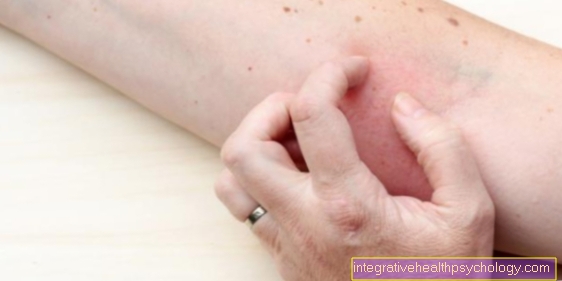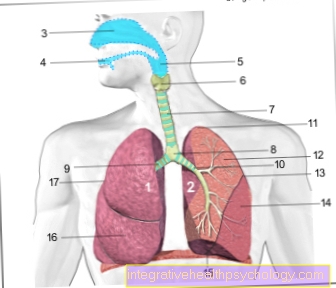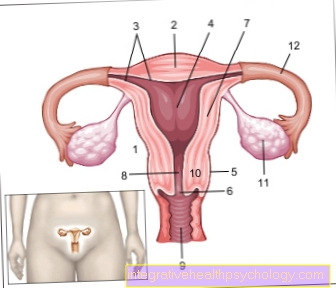Wrist pain
Synonyms
Carpal pain, wrist pain
English: wrist
introduction
Carpal pain or wrist pain can have several causes. This article provides a broad listing of the most common causes of wrist pain.
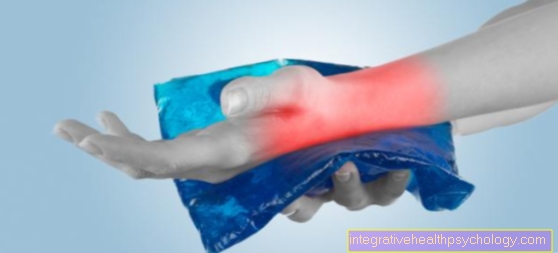
Diseases causal for wrist pain
Carpal tunnel syndrome
The most common disease in the wrist area is carpal tunnel syndrome. The carpal bones are not causally involved in this disease. Carpal tunnel syndrome often causes numbness or tingling in the area of the thumb. But the index and middle fingers can also be affected. Symptoms can also include pain. For detailed information, see Carpal Tunnel Syndrome.
Scaphoid fracture
Due to an accident, the most common disease of the wrist is the scaphoid fracture (Scaphoid fracture). The scaphoid fracture typically occurs when you fall on the outstretched wrist. The main symptoms are pain in the navicular bone. Diagnosing this condition is often difficult and cannot always be diagnosed directly from the first x-ray.
The therapy is both conservative and surgically long-term (6-12 weeks).
Further information is available under our topic: Scaphoid fracture
Read more about wrist bruises here
Scapholunal dissociation
Scapholunar dissociation (SLD) is an accident-related disease of the wrist that occurs less often than the scaphoid fracture. The ligament structures between the navicular bone (Scaphoid bone) and the moon bone (Lunate bone). Since the exact position of the carpal bones to each other is important for optimal function, an operative correction must follow depending on the extent of the scapholunal dissociation.
Further information is available under our topic: scapholunal dissociation
Thumb saddle joint osteoarthritis
As with all joints, there is arthrosis of the joints in the wrist area. The most common arthrosis in the wrist area is the thumb saddle joint arthrosis (Rhizarthrosis). The thumb saddle joint is replaced by the large polygonal bone (Os tapezium) and the first metacarpal bone. Further You can find information under our topic: Thumb saddle joint osteoarthritis
With osteoarthritis of the thumb saddle joint, the patient has stabbing and pulling pains in the area of the thumb saddle joint. At the onset of the disease, these pains appear only when the joint is loaded. In the further course, less stressful movements are painful and pain at rest can also occur. The mobility of this joint is severely limited by the pain, as the bones of the joint increasingly rub against each other with every movement.
Lunate Malacia
The lunate malacia describes a fall of the moonbone. This is a small carpal bone that can be found on the thumb side directly above the spoke next to the navicular bone. The bone can perish for various reasons and slowly break down on its own. Often, injuries or unnoticed permanent burdens are behind the clinical picture. Typical development patterns are breaks after falls, as well as constant use of jackhammers. These leave damage to the blood supply to the bone, causing the bone to slowly die. Initially the disease is not painful. If pain occurs, the lunate malacia is often well advanced and clearly visible on the X-ray. In severe cases, a loss of strength can develop and the joint needs to be stiffened.
For more information on this topic, read also: Lunate Malacia - All You Need To Know
Tendinitis
Tendonitis is an inflammation of the tendon sheaths, which in most cases occurs without the influence of pathogens due to permanent tendon irritation. Tendonitis can occur more easily on the wrist. The tendons can be painfully irritated and painful due to rotational movements, strong grasping movements and overloading of the extensor tendons of the hand. The tendonitis can spread to the elbow and cause severe pain when moving.
In tendinitis, the skin area on the back of the wrist is often swollen, red and overheated. The patient complains of severe pain, especially when the hand is stretched towards the back of the hand. In later stages there may also be pain at rest. The most important therapy is to protect the joint for a long enough time and to immobilize it.
You can find more detailed information on tendinitis here:
- Tendonitis in the hand
- Tendonitis therapy - how to get rid of the pain
neuralgia
In neuralgia, excessive irritation or inflammation causes permanent irritation of the nerve. This then continuously sends pain signals to the brain, so that there is permanent stabbing pain. Here, too, you may feel numb or tingling.
You can find more information at: neuralgia
Pain after an accident
Pain in the wrist can often be traced back to accidents and falls. Forearm fractures near the wrist are one of the most common fractures in humans. The cause of the accident is typical propping up in a fall, which can break the spoke and other structures of the wrist.
Any bone damage must be diagnosed on the X-ray. Cartilage damage or ligament tears can also occur as a result of the accident. These can be displayed using an MRI image or joint reflection.If there is a definite injury to the wrist structures, surgery may need to be performed to restore the stability of the joint.
Appointment with a hand specialist?
I would be happy to advise you!
Who am I?
My name is dr. Nicolas Gumpert. I am a specialist in orthopedics and the founder of .
Various television programs and print media report regularly about my work. On HR television you can see me every 6 weeks live on "Hallo Hessen".
But now enough is indicated ;-)
In order to be able to treat successfully in orthopedics, a thorough examination, diagnosis and a medical history are required.
In our very economic world in particular, there is too little time to thoroughly grasp the complex diseases of orthopedics and thus initiate targeted treatment.
I don't want to join the ranks of "quick knife pullers".
The aim of any treatment is treatment without surgery.
Which therapy achieves the best results in the long term can only be determined after looking at all of the information (Examination, X-ray, ultrasound, MRI, etc.) be assessed.
You can find me at:
- Lumedis - orthopedics
Kaiserstrasse 14
60311 Frankfurt am Main
Directly to the online appointment arrangement
Unfortunately, appointments can only be made with private health insurers. I ask for understanding!
Further information about myself can be found at Lumedis - Dr. Nicolas Gumpert
Diagnosis of carpal pain
A diagnosis can often be made based on the existing symptoms. However, imaging techniques should be used to confirm this. Bony structures can be seen on an X-ray. However, it should be used to assess tendons or to detect inflammation MRI scans of the wrist be made.
In the case of osteoarthritis of the thumb saddle, inflammation in the area of the joint can be recognized and, depending on the progression of the disease, a change in the bone structure.
In order to diagnose a carpal tunnel syndrome, the nerve conduction velocity should be measured in addition to various movement tests to check functionality. This is the only way to determine the function of the nerve.
The tendinitis and neuralgia can usually be identified based on the typical symptoms. In addition, imaging methods can be used here to rule out other diseases or bone involvement.
therapy
There is no cure for osteoarthritis of the thumb saddle, because it is a chronic disease in which bones are worn away by increasing friction. First of all, this will Thumb saddle joint by a splint immobilized and prescribed anti-inflammatory drugs in the form of ointments or tablets for pain relief.
If the pain increases, a direct Cortisone Injection help in the joint.
If the pain recurs or if these therapeutic approaches do not lead to any improvement, an operation should be considered. This removes the joint bone that is causing the pain and restores the functionality of the joint.
In the case of carpal tunnel syndrome, attempts are first made to relieve the symptoms with immobilization and anti-inflammatory drugs. If this does not have the desired effect, one should surgery performed in which the ligament structure that forms the carpal tunnel, the Ligamentum carpi transversum, is split so that the nerve is no longer compressed.
The tendinitis is also treated by resting, anti-inflammatory and additionally by cooling. In severe cases that result in chronic inflammation, surgery should also be considered here.
Neuralgia is treated depending on the cause. If there is an underlying nervous disease, it is important to treat it. To relieve the pain, a local anesthetic can be injected to numb the affected nerve.
Where does your pain occur?
Pain in the thumb area
Illnesses or injuries to the thumb can also be responsible for wrist pain. The most common reason for wrist pain caused by the thumb is osteoarthritis of the thumb saddle joint. This affects the joint between the large polygonal bone and the first metacarpal bone, which belongs to the thumb. It is a painful condition of the joint that is mostly due to age-related wear and tear.
But also falls that lead to a misalignment or an incorrect, one-sided load can lead to this clinical picture. In technical terms, this is called rhizarthrosis and is the most common wrist osteoarthritis in Germany. Overall, women are affected significantly more often than men.
Another cause that can cause discomfort is, for example, a so-called SMS thumb, in which the muscles and vision of the thumb are irritated due to excessive strain. Such overuse can cause symptoms that are very difficult to localize and can be interpreted as carpal complaints.
Fractures such as the so-called Bennett fracture, which affects the connection between the thumb and the wrist, can also cause severe discomfort in the wrist. Finally, diseases and injuries to the ligaments in the area of the thumb can lead to severe pain, which is usually accompanied by other symptoms such as bruising and swelling.
The so-called carpal tunnel syndrome can also cause pain in the area of the wrist on the side of the thumb.
Here the nerve that supplies part of the hand muscles and the skin there is compressed in the area of the wrist and can lead to pain or numbness.
Read more on the topic: Thumb pain
Back hand pain
Back hand discomfort can have different causes. In most cases, however, the wrist is not the primary cause of problems when the back of the hand is discomfort. Walk on the back of your hand many tendons of the muscleswhich are essential for the movement of the fingers. Inflammation of the tendons or tendon sheaths can occur Pain such as Redness and Swelling release on the back of the hand. Even if the tendons are injured, they often cause discomfort on the back of the hand. Furthermore is a arthrosis, which in the Metacarpal joints there is a common reason for the presence of discomfort on the back of the hand.
Also Nerve disorders like the so-called Cheiralgia paraesthetika, also as Wartenberg syndrome known to cause pain on the back of the hand. At the back of the hand you can also Cysts arise, which as ganglion are known. This fluid-filled space under the skin can cause severe pain on the back of the hand.
Duration of healing and prognosis
The healing time for wrist pain can vary widely.
- In most cases it is harmless bruises after falls or irritation of the sinewy or cartilaginous parts of the wrist. In these cases, with adequate rest, the symptoms subside within a few days.
- Prolonged pain can be expected from tendonitis or injury to wrist structures. Tendonitis can take several weeks to heal and immobilize.
- The time it takes to heal injuries to the bones, cartilages, or ligaments of the wrist will vary with the choice of treatment. Conservative procedures sometimes require several weeks of rest and healing. After surgical therapies, the wrist can often be loaded again earlier.
- In individual cases, injuries and diseases of the wrist can lead to long-term complaints. Even cartilage wear, known as "osteoarthritis", can result from the disease.
Illustrations wrist pain
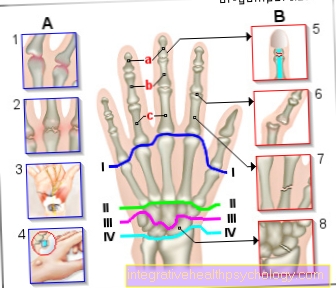
A - Chronic causes
B - Acute causes
- Rheumatoid Arthritis (RA) -
inflammatory disease
the joints - Arthrosis -
Joint wear - Carpal Tunnel Syndrome (KTS) -
constriction of the median nerve - Ganglion (upper leg) -
benign tumor formation - Torn ligament -
Rupture of a joint ligament - Finger dislocation -
Dislocated finger - Broken finger (finger fracture) -
a - distal
b - medial
c - promaximal - Wrist hernias
(here scaphoid fracture)
I - I - metacarpal joint -
Articulatio metacarpophalangea
II - II - Carpal-metacarpal joints -
Articulationes carpometacarpales
III - III - Lower wrist -
(distal)
Articulatio mediocarpalis
IV - IV - Upper wrist -
(proximal)
Articulatio radiocarpalis
You can find an overview of all Dr-Gumpert images at: medical illustrations
Figure carpal bones
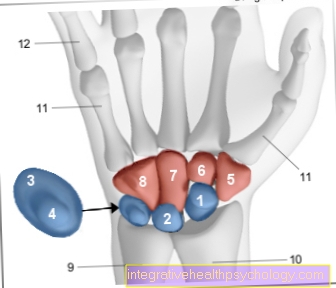
The eight carpal bones
Upper (proximal) row - blue
Lower (distal) row - red
- Scaphoid bone of the hand -
Scaphoid bone - Moonbone - Lunate bone
- Triangular leg - Os triquetrum
- Pea bone - Os pisiform
- Large polygonal leg
(Trapezoidal leg) - Trapezium - Small polygonal bone
(Trapezoid leg) -
Trapezoid bone - Head leg - Os capitatum
- Hook leg - Hamate bone
- Cubit - Ulna
- Spoke - radius
- Metacarpal bones - Metacarpals
- Phalanx - Ph. Proximalis
You can find an overview of all Dr-Gumpert images at: medical illustrations







